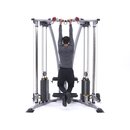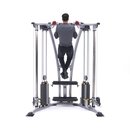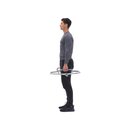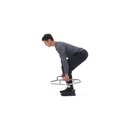If you walked into my gym in Baltimore, you’d notice my clients and athletes never stop moving. It doesn’t matter if they’re bodybuilders, powerlifters, combat athletes, injury-rehab clients, or just people training for general fitness. They all keep moving.
If nobody explained what these clients were doing, you’d probably get the wrong idea. You might say “circuit training,” which it definitely isn’t. You might also guess “supersets.” That’s closer to the truth because they’re usually alternating between two exercises. The difference is they’re not rushing between exercises, because I’ve programmed a minute or more of rest between exercises and sets.
These clients are training with paired sets, a deceivingly simple training style that has been a major component of my training in recent years and is the backbone of both of my BodyFit programs, Combat Fit: 8-Week ACFT Training Plan and True Muscle: 9 Weeks to Elite Fitness. You can see paired sets in action in this full-body strength and power workout from True Muscle, featuring former NFL star Steve Weatherford.
What’s so special about paired sets? As the names of both of those programs should imply, they’re simply fantastic at building multiple qualities at once. You can add muscle while getting stronger, get conditioned while maintaining strength—and just be tougher and more capable overall—without the risk of burnout that often comes with circuits or supersets.
Here’s what you need to know about the best training style you’re probably not using.
What is paired-set training?
Whereas there is no rest between exercises within a superset, you rest strategically between exercises when doing a paired set. Here are a few examples of paired sets:
Paired set example 1
1a. Barbell or dumbbell bench press: 4 sets, 5 reps (rest 1 min.)
1b. Dumbbell single-leg Romanian deadlift: 4 sets, 5 reps per leg (rest 2 min)
Paired set example 2
1a. Lat pull-down or chin-up 3 sets, 8 reps (rest 1 min.)
1b. Dumbbell shoulder press 3 sets, 8 reps (rest 2 min.)
 ://www.bodybuilding.com/images/2021/january/the-most-important-training-technique-to-know-this-year-1-700xh.jpg”/>
://www.bodybuilding.com/images/2021/january/the-most-important-training-technique-to-know-this-year-1-700xh.jpg”/>
Paired set example 3
1a. Barbell squat 3 sets, 5 reps (rest 1 min.)
1b. Arm walk-out 3 sets, 5-8 reps (rest 2 min.)
Simple enough, right? But what a difference a minute or two makes. In the case of these pairings, it means that the lifter is able to move more weight on big multijoint exercises than they would performing supersets, while still being able to repeat it for set after set.
To that end, research shows that paired-set training may be more effective than traditional-set training at enabling lifters to handle more volume in their workout.[1] But it shouldn’t take researchers to see that paired sets are a perfect training strategy for anyone who wants to get the most out their workout time and maximize muscle gains.
What is the best rest between sets for muscle and strength?
A review of the research for rest intervals between sets found that resting 3-5 minutes between sets produced greater increases in strength by allowing your body ample time to recover. Likewise, higher levels of muscular power were demonstrated over multiple sets with 3-5 minutes of rest versus 1 minute of rest between sets.[2]
Paired sets allow more space to recover than bang-bang supersets, putting you closer to that 3-5-minute range to overcome localized fatigue in working muscles. This means you’ll be able to handle heavier weights than in supersets.
You could try to stretch it out even longer, but resting longer than 3-5 minutes doesn’t necessarily mean performance will increase further. Plus, you’ve only got so much time to work out anyway.
You might fear that you’re losing the conditioning or fat-loss benefits of supersets by adding a minute or two of rest in there, but try a full workout structured this way, and you’ll quickly see that you’re still getting a serious cardiovascular training effect.
 ://www.bodybuilding.com/images/2021/january/the-most-important-training-technique-to-know-this-year-2-700xh.jpg”/>
://www.bodybuilding.com/images/2021/january/the-most-important-training-technique-to-know-this-year-2-700xh.jpg”/>
What exercises are best for paired-set training?
There are plenty of great exercise pairings you can choose from. However, the best paired sets adhere to these three simple rules:
1. Pair Non-Interfering Exercises
When pairing exercises, you don’t want to exhaust the same muscles on both exercises because it interferes with your recovery and performance. So, whatever muscles are being worked in the first exercise, the second exercise in your paired set should be for a different muscle group.
By choosing non-interfering exercises as your paired sets, it allows you to rest longer between sets of the same muscle group, while maximizing your overall training time by doing a set targeting a different muscle group. In other words, you’re using the second exercise to help with recovery from the first one, which means you can then work harder in subsequent sets.
By the time you get back to training the same muscle group on the following set, it’s been several minutes, leaving those muscles plenty of time to fully recover and get ready to exert maximal intensity with every set.
You’ll accomplish more work in the same amount of time, without compromising anything or requiring more rest and recuperation in between workouts.
2. Exercise Pairs Must Make Logistical Sense
There’s an old saying that a good craftsperson never blames the tools. This perspective applies perfectly to our strength-training workouts because we’re not always able to use all of the exercise equipment we’d like to. In many cases, the specific thing that limits us is being in a crowded gym where almost every piece of equipment has someone on it.
 ://www.bodybuilding.com/images/2021/january/the-most-important-training-technique-to-know-this-year-3-700xh.jpg”/>
://www.bodybuilding.com/images/2021/january/the-most-important-training-technique-to-know-this-year-3-700xh.jpg”/>
That said, when doing paired sets, make sure your pairings meet one of these rules:
- They include exercises using the same piece of equipment.
- They include exercises pairing a piece of immobile equipment (e.g., a bench press, squat rack or machine) with exercises using mobile equipment (e.g., dumbbells, resistance bands, or body weight).
- They include exercises pairing two pieces of mobile equipment or body weight.
This approach enables you to avoid the risk of “losing” a piece of equipment while walking across the gym. It also saves time, and saves you and the other gym members a lot of frustration.
3. Use Paired Sets for Compound Exercises, Supersets for Isolation Exercises
Since compound exercises involve more muscles and usually heavier loads, they are more taxing on your body than isolation exercises. Therefore, it makes sense to use paired sets when grouping two compound exercises together, or when grouping a compound exercises with an isolation exercise. This allows you to accomplish more work without making any particular muscle group so exhausted you can’t go hard on each set.
That said, since isolation exercises by nature are less taxing on your body, you can do supersets if you prefer, or trisets of three non-interfering isolation exercises with as little rest as possible between them. That’s the approach in the ACFT training program I created for BodyFit.
This is also a concession to that person who looks at a paired set workout and says, “But what about the pump?” For example, in my article “The Gritty Workout Your Upper Body Needs,” after three paired sets of presses, raises, and flyes, I recommend performing a no-rest superset-style pairing of dumbbell scaption raises and triceps push-downs, followed by a density set of 50 dips for time.
 ://www.bodybuilding.com/images/2021/january/the-most-important-training-technique-to-know-this-year-4-700xh.jpg”/>
://www.bodybuilding.com/images/2021/january/the-most-important-training-technique-to-know-this-year-4-700xh.jpg”/>
Try that workout and get back to me about whether or not you got a pump.
Paired Set Workout
These workouts utilize paired sets and trisets, and follow an upper-body/lower-body split, so you can optimize your workout time and maximize your results. I recommend alternating between these workouts, training no more than two days in a row before taking a rest day to allow for recovery.
Workout Directions:
- Perform all sets of a given set of exercises before moving on to the next paired set.
- Rest 1 minute between exercises within a paired set.
- Rest 30 seconds between exercises within a triset.
- Rest 1-2 minutes after completing each round of a paired set or triset.
- Adjust the prescribed rest periods a bit according to your fitness level. Need more rest? Take it.
- Maintain strict form on all exercises.
- Use a weight load that allows you to perform the minimum number of reps indicated next to each exercise, while also leaving you unable to perform any more reps than the maximum number indicated while maintaining proper control and technique.
Upper-Body Paired Set Workout for Strength and Muscle PAIRED SET Perform the exercises in order, resting 1 min. between exercises and sets. 4 sets, 6-10 reps (rest 1 min. ) 
 + 4 more exercises
+ 4 more exercises  ://www.bodybuilding.com/images/2021/january/the-most-important-training-technique-to-know-this-year-5-700xh.jpg”/> Lower-Body Paired Set Workout for Strength and Muscle PAIRED SET Perform the exercises in order, resting 1 min. between exercises and 1-2 min. between sets. Hex-bar deadlift 4 sets, 6-10 reps (rest 1 min. )
://www.bodybuilding.com/images/2021/january/the-most-important-training-technique-to-know-this-year-5-700xh.jpg”/> Lower-Body Paired Set Workout for Strength and Muscle PAIRED SET Perform the exercises in order, resting 1 min. between exercises and 1-2 min. between sets. Hex-bar deadlift 4 sets, 6-10 reps (rest 1 min. ) 
 + 4 more exercises
+ 4 more exercises
References
- Robbins, D. W., Young, W. B., & Behm, D. G. (2010). The effect of an upper-body agonist-antagonist resistance training protocol on volume load and efficiency. The Journal of Strength & Conditioning Research, 24(10), 2632-2640.
- de Salles, B. F., Simao, R., Miranda, F., da Silva Novaes, J., Lemos, A., & Willardson, J. M. (2009). Rest interval between sets in strength training. Sports Medicine, 39(9), 765-777.






Leave a Reply
You must be logged in to post a comment.